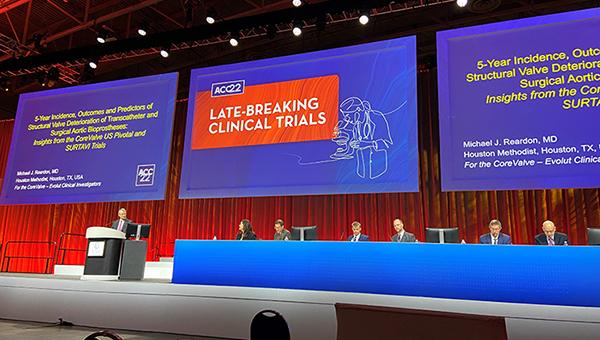Self-Expanding TAVI Looks More Durable Than SAVR at 5 Years
The results challenge the dogma that younger patients, on the basis of better valve longevity, should get a surgical valve.

WASHINGTON, DC—Structural valve deterioration is more common during midterm follow-up among patients with severe symptomatic aortic stenosis treated with a surgical bioprosthesis compared with those who receive the supra-annular, self-expanding transcatheter heart valve (Medtronic), according to a new analysis.
The study, which combined data from multiple trials, showed that the rate of structural valve deterioration at 5 years with surgery was 4.38% versus 2.57% in patients undergoing TAVI (P = 0.0095).

Michael Reardon, MD (Houston Methodist, TX), who presented the results today during the late-breaking clinical trial session at the American College of Cardiology (ACC) 2022 Scientific Session, said the results are important because they will help physicians in their conversations with patients.
“Every week I have patients coming to my clinic who would be both suitable for TAVI and surgery, and one question they always ask me is how long will the valve last,” he said. “How likely is it for the valve to dysfunction? This helps us answer that.”
Megan Coylewright, MD (Erlanger Health System, Chattanooga, TN), who wasn’t involved in the study, told TCTMD these new data challenge the previously held assumption that surgical valves last longer than transcatheter bioprostheses. “I don’t know if this yet helps us understand the question of durability, but there have been patients with long life expectancies who have been told that they have to have a surgical valve because they last longer,” said Coylewright. “This [study] throws that comment into question.”
Reardon agreed with that assessment. “For years, surgeons have told people that you have to have a surgical valve because they have longer-term data and they last longer,” he said. “Well, based on [these data], that’s not true. I think it will change the discussion with the heart team.”
Cardiac surgeon Richard Whitlock, MD, PhD (McMaster University/Population Health Research Institute, Canada), who also does TAVI cases, said the analysis shows the CoreValve device performing very well over 5 years, even outperforming surgical valves based on hemodynamic criteria for structural valve deterioration. He praised the investigators, saying it’s great news for patients there are no signs of early structural valve deterioration with TAVI.
While some surgeons might not like the results, physicians must remember that “we’re here to treat patients with the heart team,” said Whitlock.
Randomized and Nonrandomized Data
For the study, investigators compared rates of structural valve deterioration with TAVI and surgery using two randomized, controlled trials: the CoreValve US High-Risk Pivotal Trial and SURTAVI, in intermediate-risk patients, for a combined total of 2,099 patients. To determine the relationship between clinical outcomes and structural valve deterioration, they also included 2,663 patients from the CoreValve US Extreme-Risk Study and CoreValve Continued Access Study.
For the analysis, structural valve deterioration was defined as moderate or greater hemodynamic changes, which included an increase in mean gradient ≥ 10 mm Hg from discharge/30-day echocardiogram to last available echocardiogram and a mean gradient ≥ 20 mm Hg at last available echocardiogram. Structural valve deterioration could also include new onset or a moderate or greater increase in intra-prosthetic aortic regurgitation.
Overall, structural valve deterioration was significantly lower with TAVI in the two randomized trials. In patients with smaller annular diameters (≤ 23 mm), the rate of structural valve deterioration was 5.86% at 5 years with surgery versus 1.39% in patients treated with TAVI (P = 0.05). In those with larger annular diameters (> 23 mm), there was only a trend toward less structural valve deterioration with TAVI compared with surgery (2.48% vs 3.96%; P = 0.067).
In the pooled cohort of surgical and TAVI-treated patients, structural valve deterioration was associated with a higher risk of all-cause (HR 1.98; 95% CI 1.42-2.76) and cardiovascular mortality (HR 1.82; 95% CI 1.17-2.84). Hospitalization for aortic valve disease/worsening heart failure was also significantly higher in patients with structural valve deterioration (HR 2.11; 95% CI 1.19-3.74). Looking only at TAVI-treated patients, structural valve deterioration was associated with more than a twofold higher risk of all-cause and cardiovascular mortality, as well as hospitalization for aortic valve disease/worsening heart failure. The same findings were observed in the surgical patients, although valve deterioration was only associated with a trend toward higher hospitalizations.
Correlating Clinical Outcomes
Reardon said that this is the first study to demonstrate a correlation between structural valve deterioration—which they defined with serial Doppler transthoracic echocardiography—with adverse clinical outcomes. Notably, the Valve Academic Research Consortium (VARC)-3 and European Association of Percutaneous Coronary Interventions (EAPCI) use different definitions of structural valve deterioration, which have never been validated with clinical events, he said.
“This helps me to answer my patient who asks that second question—if my valve does become dysfunctional, what does that mean to me? Will it harm me?” said Reardon, noting that the answer is clearly yes.
In multivariate modeling, patient age, male, prior PCI, and prior atrial fibrillation/flutter were associated with a lower risk of valve deterioration. There was a higher risk of valve breakdown in patients with a higher body surface area.
Whitlock pointed out that the relative benefit of TAVI over surgery appears to be driven by lower rates of structural valve deterioration with TAVI in patients with smaller annuli.
“That speaks to the importance of ‘right-size’ prostheses and the importance of getting as large a prosthesis as you can into a patient,” Whitlock told TCTMD, echoing a similar point about effective orifice area made by Reardon in the Q&A following his presentation. “It even emerges in the predictors for structural valve deterioration where body surface area is a predictor.”
He added there are also data showing that smaller valves deteriorate faster.
“I do a lot of [aortic] root enlargements now to ensure that I at least get a size 25 [mm] into patients,” said Whitlock. “That’s the new era. Aortic-valve interventionalists—they can be surgeons or interventionalists, and many surgeons do both surgery and TAVI—have come to recognize that we’ll likely give the patient better long-term durability with a larger valve but also prepare them for a valve-in-valve in the future if they do need it.”
In terms of predictors, Whitlock said there’s no biological reason why a prior PCI or atrial fibrillation (AF) would be associated with a lower risk of valve breakdown. However, these patients would likely be treated with more-intensive antithrombotic protection, and this may be the reason why prior PCI/AF appears to be protective against structural valve deterioration. Analyses stratifying patients based on antithrombotic therapy—a single agent versus more aggressive treatments, for example—would be an important next analysis, he said.
A ‘Win-Win’ for TAVI
Speaking during the media briefing, Coylewright noted that structural valve deterioration has historically been measured inconsistently, if at all, and this has led to some doubt about how well transcatheter heart valves stack up against surgical bioprostheses.
“Before transcatheter aortic valve replacement, we measured valve failure by whether patients went back to the operating room or not,” she said. By contrast, the definition used in this analysis, comes “after years of work, defining how we’re going to follow these patients over time and what defines the valve breaking down.”
For Adam Greenbaum, MD (Emory University School of Medicine, Atlanta, GA), who wasn’t involved in the study, these new results aren’t too surprising given the lack of a rigorous definition for structural valve deterioration and detailed follow-up of surgical patients. He noted that 5 years follow-up is still insufficient, noting that many valves—transcatheter and surgical—can “look great until the cliff just drops out at 8, 9, or 10 years.”
Nonetheless, the data are solid at this time point for the self-expandable valve, Greenbaum told TCTMD. “The valve is placed up high; they do have high, long commissures,” he said. “There is data that it does reduce leaflet stress. It might be a design issue. . . . There could be a difference in mechanical forces [versus balloon-expandable transcatheter valves].”
Speaking with TCTMD, interventional cardiologist Suzanne Baron, MD (Lahey Hospital & Medical Center, Burlington, MA), agreed that the difference in valve durability with the self-expandable bioprosthesis versus the surgical valve is likely the result of the former’s supra-annular valve design, which allows for greater neo-sinus flow and less hypoattenuated leaflet thickening (HALT), which in turn reduces the risk of structural valve deterioration.
Reardon noted that every surgical valve fails at a different rate, and it’s likely that every transcatheter heart valve will fail at different rates, too. Most recently, Philippe Pibarot, DVM, PhD (Quebec Heart & Lung Institute/Laval University, Canada), published 5-year data from PARTNER 2 study showing that the second-generation, balloon-expandable Sapien XT (Edwards Lifesciences) had a higher rate of structural valve deterioration compared with surgery, but the next-generation Sapien 3 device had rates that were equivalent to surgery.
Reardon said the PARTNER 2 data showing equivalent rates of deterioration with Sapien 3 and surgery at 5 years were considered a “win” for TAVI. These new CoreValve data showing the valve outperformed surgery at 5 years can be viewed as a “win-win.”
For Coylewright, all of the data published out to 5 years are showing that TAVI devices are lasting as long as surgical bioprostheses. “That’s what we know so far,” she said.
Lifetime Management of Patients
Baron, calling the data “compelling,” says the new analysis shows “that even moderate degrees of structural valve deterioration had an impact on hard clinical outcomes.”
Whitlock also praised the investigators for showing a correlation between the structural valve deterioration and clinical outcomes, noting that the hemodynamic definition of deterioration really serves as a surrogate for endpoints that matter most for physicians and patients.
Whitlock and Baron both said interventional cardiologists are increasingly thinking about the lifetime management of patients, particularly younger patients, with severe symptomatic aortic stenosis. “We’re starting to think about coronary access, what sort of valve they may need when the valve does eventually fail,” Baron told TCTMD. Now, with these new data, it will be another discussion point in the conversation between patients and physicians. However, she stressed the need for more follow-up.
“We absolutely need to have the 10-year data, especially given that a lot of the patients that we’re treating are in their late 60s or early 70s,” she said. “The reality is we’ll be seeing again. It’s key to follow these [CoreValve] patients further.”
Michael O’Riordan is the Managing Editor for TCTMD. He completed his undergraduate degrees at Queen’s University in Kingston, ON, and…
Read Full BioSources
Reardon MJ, et al. Five-year incidence, outcomes, and predictors of structural valve deterioration of transcatheter and surgical aortic bioprostheses: insights from the CoreValve US Pivotal and SURTAVI trial. Presented at: ACC 2022. April 4, 2022. Washington, DC.
Disclosures
- Reardon reports research grants from Abbott, Boston Scientific, Medtronic, and Gore Medical.





Comments